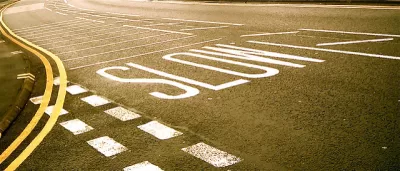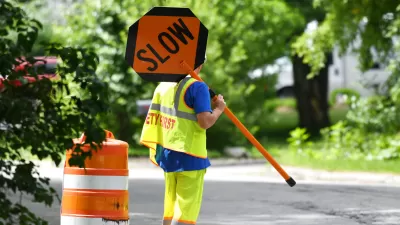Two safe streets advocates give their recommendations for how to effectively use the $1 billion in annual funding available through a federal grant program.

Writing in Streetsblog, Melissa Balmer and Leah Shahum outline some ideas for how cities can effectively put to use the annual $1 billion dedicated to Vision Zero projects through the Safe Streets and Roads for All (SS4A) grant program.
The authors outline the basics of the program: who can apply, due dates, and what kind of projects qualify. Encouragingly, they write, “This is a mercifully streamlined application process, so don’t be daunted! While a 20 percent match is required, there are creative ways to fulfill that requirement.”
Balmer and Shahum suggest ways that communities can use these grants. First and foremost, it’s important to develop a “strong and equitable” Vision Zero plan that “can help your community institutionalize Vision Zero, setting explicit timelines, deliverables, and accountability measures.”
Second, the authors write, “Think Big, Bold & System-Wide for Implementation Projects.” The federal funding can support infrastructure projects that put action plans into literal action, such as “widespread, high-impact, cost-effective design treatments” such as speed humps, improved crosswalks, and other traffic calming measures.
Thirdly, the authors highlight a number of projects that would qualify for supplemental planning grants, such as racial and health equity plans for roadway safety work, reforming traffic enforcement with a focus on safety without over-criminalization, and education on Safe System principles.
FULL STORY: OPINION: How To Use the Money Available for Safe Streets

Maui's Vacation Rental Debate Turns Ugly
Verbal attacks, misinformation campaigns and fistfights plague a high-stakes debate to convert thousands of vacation rentals into long-term housing.

Planetizen Federal Action Tracker
A weekly monitor of how Trump’s orders and actions are impacting planners and planning in America.

In Urban Planning, AI Prompting Could be the New Design Thinking
Creativity has long been key to great urban design. What if we see AI as our new creative partner?

Cal Fire Chatbot Fails to Answer Basic Questions
An AI chatbot designed to provide information about wildfires can’t answer questions about evacuation orders, among other problems.

What Happens if Trump Kills Section 8?
The Trump admin aims to slash federal rental aid by nearly half and shift distribution to states. Experts warn this could spike homelessness and destabilize communities nationwide.

Sean Duffy Targets Rainbow Crosswalks in Road Safety Efforts
Despite evidence that colorful crosswalks actually improve intersection safety — and the lack of almost any crosswalks at all on the nation’s most dangerous arterial roads — U.S. Transportation Secretary Duffy is calling on states to remove them.
Urban Design for Planners 1: Software Tools
This six-course series explores essential urban design concepts using open source software and equips planners with the tools they need to participate fully in the urban design process.
Planning for Universal Design
Learn the tools for implementing Universal Design in planning regulations.
Appalachian Highlands Housing Partners
Gallatin County Department of Planning & Community Development
Heyer Gruel & Associates PA
Mpact (founded as Rail~Volution)
City of Camden Redevelopment Agency
City of Astoria
City of Portland
City of Laramie





























